Chapter 5¶
As seen in Chapters 1-3, research hypotheses involving either a single categorical variable or two categorical variables require us to test claims about proportions. When a research question involves a single numerical variable, however, we typically end up testing claims about the mean, or average. In this chapter, we will consider inferential methods (hypothesis tests and confidence intervals) for the mean of a single numerical variable. Consider the following example.
Example 5.1:¶
A study conducted by researchers at Pennsylvania State University investigated whether time perception, a simple indication of a person’s ability to concentrate, is impaired during nicotine withdrawal. The study results were presented in the paper “Smoking Abstinence Impairs Time Estimation Accuracy in Cigarette Smokers” (Psychopharmacology Bulletin [2003]: 90-95). After a 24-hour smoking abstinence, 20 smokers were asked to estimate how much time had passed during a 45-second period. Suppose the resulting data on perceived elapsed time (in seconds) were analyzed as shown below (these results are artificial but are similar to the actual findings). The data can be found in the file Nicotine1.JMP.
We can use JMP to summarize the data as follows:
-
Q-910: What is the mean of the observed data?
- (A) 55.05
- That is the mean of the data.
- (B) 9.33
- That is the standard deviation of the data.
- (C) 2.09
- That is the standard error of the mean.
-
Q-911: What is the standard error of the mean?
- (A) 55.05
- That is the mean of the data.
- (B) 9.33
- That is the standard deviation of the data.
- (C) 2.09
- That is the standard error of the mean.
-
Q-912: If another sample of (n = 20) subjects were obtained, would these new
subjects have a mean exactly the same as the mean from this
sample? Why or why not?
- (A) Yes
- We would expect some variability from one sample to the next.
- (B) No
- We would expect some variability from one sample to the next.
THE DISTRIBUTION OF THE SAMPLE MEAN¶
The sample mean is a random quantity; that is, it changes from sample to sample. Therefore, the sample mean actually has its own distribution. This distribution will tell us two things:
- What values the sample mean can assume.
- How often it will assume these values.
This distribution is referred to as the distribution of the sample mean. An understanding of this distribution allows us to make decisions about a population mean for a single numerical variable.
Exploring the Distribution of the Sample Mean¶
Before we discuss the procedure for inference, let’s consider the next example to gain a better understanding of how the distribution of sample means works and how we use this distribution to make a decision concerning our research question.
Example 5.2: Another “simulation study”….¶
Suppose we set up a hypothetical population of smokers suffering from nicotine withdrawal. We will do this by taking bootstrap samples from the sample in TinkerPlots.
Note
We could also generate this distribution using StatKey, but we will use TinkerPlots here as an introduction.
Question
In this simulation study, what is our value of μ, the true population mean?
Note that in reality, the true population mean is usually an unknown quantity which we are trying to estimate. Since it is not feasible to collect data on the entire population of smokers suffering from nicotine withdrawal, the researchers took a random sample of 20 subjects in order to estimate the average perceived elapsed time. Let’s see what happens when we take various samples of size 20 from this population.
We can use Tinkerplots to carry out this simulation. Each of the elements in the mixer represents the perceived elapsed time for a smoker suffering from nicotine withdrawal in the population (e.g., the highlighted subject thought that 50 seconds had passed during a 45-second period). We set the repeat value to 20 in order to randomly select 20 subjects from the population for our study.
Click Run to randomly select our first sample of 20 subjects, and we can then create a plot of their perceived elapsed times. Note that the mean of these 20 subjects is shown on this plot.
Sample # 1:¶
Even though in reality we would carry out a study only once, we will use Tinkerplots to take a sample of 20 subjects from this population over and over again so that we get an idea of how much the sample mean could change from sample to sample. Our second and third random samples of 20 subjects and their sample means are shown below:
Sample #3:¶
We can start to collect these sample means in a new plot to create the distribution of sample means:
To get a really good idea of what values are likely to occur by chance when taking random samples of size 20 from the population, we should take more than just three samples. The graphic below shows the process we used to create the distribution of sample means and the final plot of the means of 1,000 random samples.
This is a distribution of sample means. Recall that these 1,000 samples (each consisting of 20 subjects) came from a population with a true mean perceived elapsed time of 45 seconds. So, this distribution gives us a good idea of what sample means from 20 subjects are likely (or unlikely) to occur by chance if the true mean is 45 seconds.
The Central Limit Theorem¶
Note that a statistician would not necessarily carry out a simulation study such as this to answer a research question. Instead, one could use “short-cuts” known as a t-test or confidence interval to investigate a research question concerning a single population mean. These short-cuts are results of something known as the central limit theorem, which states the following:
The Central Limit Theorem for the Mean
Consider a random sample of n observations from ANY population with mean µ and standard deviation σ. The distribution of sample means will have a mean of \(\mu\) and a standard deviation of \(\sigma/\sqrt{n}\). When \(n\) (the number of subjects in the sample) is sufficiently large, this distribution will be approximately NORMAL; moreover, this approximation gets better as the sample size (\(n\)) increases.
We can see the Central Limit Theorem applied to the sample means calculated from our hypothetical population from Example 5.2 as follows:
- We see that this normal distribution is centered at the true population mean, \(\mu = 45\).
- The standard deviation of all observations in our hypothetical population is \(\sigma = 9.4\) seconds. According to the central limit theorem, then, the standard deviation of the distribution of sample means is given by \(\sigma/\sqrt{n} = 9.4/\sqrt{20}=2.1\)
- We see that the distribution of sample means is approximately normal.
Finally, recall from the previous chapter that given the mean and standard deviation of a distribution, we can determine whether a given observation is an outlier or not based on its position on this distribution. This will help us decide whether the sample mean actually observed in the research study is an outlier based on the distribution that assumes the null hypothesis is true.
The only question that remains is this: How large does n (the number of subjects in a study) have to be in order for us to use the short-cut provided by the Central Limit Theorem?
How large does n have to be?¶
We have seen that the distribution of the sample mean will not always be bell-shaped and often retains some of the features of the original population, such as a skewed shape. Next, we give some guidance on when it is reasonable to assume that the distribution of sample means will be normal.
Normal Population
If the original population is normally distributed, then the sampling distribution of the mean will also be normally distributed even if the sample size n is very small
(verify this using Tinkerplots as shown in class).
Skewed Population
The more skewed the distribution, the larger the sample size must be before the normal approximation fits the distribution of sample means well.
General Rule
For almost all populations, samples of size n ≥ 30 or 40 subjects will be sufficient to say that the distribution of sample means is approximately normal. However, if the distribution is very skewed, the sample size may have to be much larger than 30 in order for the central limit theorem to apply.
In summary, we can use the Central Limit Theorem to help us create procedures for answering questions about the population mean, be it comparing the mean to some hypothesized value or estimating the value of the population mean with an interval.
This works because:
- We know the distribution of sample means will be approximately normal if either (i) the original population is normally distributed, or (ii) our sample size is sufficiently large.
- We know the distribution of sample means will be centered at the true population mean
- We know that the variability in the distribution of sample means is given by \(\sigma/\sqrt{n}\) (i.e., the variability decreases as the sample size gets larger, which we can see in the above examples).
In the next section, we put all of the pieces together to create what is a t-confidence interval. .. known as the t-test.
THE T-TEST FOR A SINGLE POPULATION MEAN¶
Back to Example 5.1:¶
Recall that the researchers wanted to show that the mean perceived elapsed time for smokers suffering from nicotine withdrawal was greater than the actual 45 seconds that had elapsed. The data collected in the study were summarized as follows:
Step 1: Set up the null and alternative hypotheses
Ho:
Ha:
Step 2: Find the t-statistic and the p-value
To determine whether or not the distance between µ (the hypothesized population mean) and (the mean from our observed sample) is larger than what we would expect by random chance, we will use the following statistic:
Why use this statistic? Because this quantity measures the position of our observed sample mean on the null model, just like the Z-score discussed in the previous chapter.
Note that this is very much like the Z-score, with one minor exception. We don’t know the true population standard deviation, σ, so we estimate it with the standard deviation calculated from the 20 observed subjects in the study (this estimate is commonly denoted by s).
This t-statistic comes from what is called a t-distribution. The amount of variability in a t-distribution depends on the sample size n (the greater the sample size, the smaller the standard deviation of the distribution of sample means). Therefore, this distribution is indexed by its degrees of freedom (df).
Note
For inference on a single mean,
To find the p-value associated with this test statistic, we must remember that this is an upper-tailed test (we are trying to find evidence that the mean is greater than 45 seconds). So, the p-value will be the probability we would observe a sample mean (or a t-statistic) greater than that obtained in the actual study by chance alone, assuming the null hypothesis is true:
To obtain this p-value from JMP, go to the output displaying the distribution of perceived elapsed time, click on the red drop-down arrow next to the variable name, and select Test Mean.
Enter the value from the null hypothesis as shown:
JMP returns the following:
Step 3: Write a conclusion in the context of the problem
Checking the Normality Assumption:¶
For the t-test to be valid, at least one of the following conditions must be met:
- Either the sample size is sufficiently large (greater than 30 or so), or
- The distribution of the observed data is approximately normal (which would indicate that the population is normally distributed so that the Central Limit Theorem would apply even with a small sample size)
For Example 5.1, we have a sample size of 20 subjects, which is not sufficiently large. So we must check whether the data seem to come from a normal distribution. The histogram seems to indicate that this is a reasonable assumption:
We can also use JMP to create a normal quantile plot. To do this, select this option from the red drop-down arrow next to the variable name.
Example 5.3:¶
For the data given in Example 5.1, we found evidence that the mean perceived elapsed was in fact greater than the actual 45 seconds that had elapsed. This study alone, however, doesn’t really prove that the nicotine withdrawal was what impaired one’s perception of time. Why not?
Suppose that the researchers also studied 20 subjects who were smokers that did NOT abstain from smoking prior to the data collection (so, they were not suffering from nicotine withdrawal). Data on their perceived elapsed times are given in the file Nicotine2.JMP.
Research Question:
Is there evidence the mean perceived elapsed time for all smokers not suffering from nicotine withdrawal is significantly greater than the actual 45 seconds?
Carry out the formal t-test to address this research question.
Step 1: Set up the null and alternative hypotheses
Ho:
Ha:
Step 2: Find the t-statistic and the p-value
Finding the p-value:
Step 3: Write a conclusion in the context of the problem
Checking the Normality Assumption:¶
For the t-test to be valid, at least one of the following conditions must be met:
- Either the sample size is sufficiently large (greater than 30 or so), or
- The distribution of the observed data is approximately normal (which would indicate that the population is normally distributed so that the Central Limit Theorem would apply even with a small sample size)
Once again, since the sample size is fairly small, we must check to see if the data are approximately normal:
NONPARAMETRIC TESTS: THE WILCOXON SIGNED RANK TEST¶
When problems with normality in the data are present, there exists an alternative to the standard t-test: the Wilcoxon Signed Rank test. This procedure does not require that the data be normally distributed; however, THE DATA SHOULD BE SYMMETRIC IN ORDER FOR THIS PROCEDURE TO BE APPROPRIATE.
Technically, this tests whether the median differs from some hypothesized value. To carry out this nonparametric test in JMP, choose this option when you select Test Mean:
JMP returns the following output:
Confidence Interval for a Single Population Mean¶
In Example 5.1, we found evidence that the mean perceived elapsed time for smokers suffering from nicotine withdrawal significantly differed from the actual 45 seconds of time that had elapsed. Our next question is obvious: HOW MUCH does it differ? To answer this question, we must construct a confidence interval.
Recall our discussion of confidence intervals from earlier in the semester:
This procedure does NOT require any hypotheses concerning our population parameter of interest (the mean, in this case). We will use both our sample data (in particular, the observed mean) and what we know about the distribution of sample means to obtain a range of likely values for our population mean.
Example 5.4: Our goal is to construct a 95% confidence interval for the mean perceived elapsed time for smokers suffering from nicotine withdrawal. To do this, we will center our distribution of sample means on the observed mean. Then, we will find the lower and upper endpoints that separate the middle 95% of the distribution from the rest (since we are constructing a 95% confidence interval).
The formula for calculating the endpoints of this confidence interval is given as follows:
The appropriate t-quantile can be found using JMP. To find this value, you need the following information:
- confidence level =
- df =
Open a new JMP data table and choose Probability > t Quantile from the Formula editor. Enter the following:
Here is an animated GIF of the process.
For this example, JMP returns the following t-quantile:
Also, recall from Example 5.1 that the mean and standard deviation are as follows:
Use this information to find the endpoints of the confidence interval:
Lower endpoint: \(\bar{x}-t_{quantile}\left(s/\sqrt{n}\right) = 55.05 - 2.093*\frac{9.327}{\sqrt{20}} = 50.68\)
Upper endpoint: \(\bar{x}+t_{quantile}\left(s/\sqrt{n}\right) = 55.05 + 2.093*\frac{9.327}{\sqrt{20}} = 59.42\)
Confidence Intervals for the Mean in JMP¶
Note that JMP automatically provides the endpoints of the 95% confidence interval for this mean when you analyze the distribution of the variable of interest.
Questions:
- Interpret the meaning of this interval. What does this interval tell us about the true mean perceived elapsed time for all smokers that are suffering from nicotine withdrawal?
- Does this interval agree with what you learned from the hypothesis test? Explain.
- How would your calculations change if you wanted to obtain a 90% confidence interval, instead?
Confidence Intervals for the Population Standard Deviation¶
If the original population is bell-shaped, then there is also a formula for the population standard deviation. This is due to the fact that, for normal data, the distribution of the standard deviation squared (also known as the variance) has a chi-square distribution.
While it is certainly possible to compute a confidence interval using the formula, it is more convenient to compute these intervals using the built-in JMP functions. We can generate a confidence interval for both the population mean and standard deviation as follows.
Constructing Confidence Intervals for the Mean and Standard Deviation in JMP
- Enter the sample data in a new data table.
- Perform ANALYZE > DISTRIBUTION on the column of interest.
- Click on the triangle above the distribution and select confidence intervals.
Caution
We need to make sure that the original data is fairly normal before relying on the formula for the confidence interval for a standard deviation. If there is any doubt about this normality, we would be better off using the bootstrap interval instead.
Picking the Correct Procedure¶
Now that we have a choice between using the bootstrap and using the JMP intervals, we need some rules on which procedure is the right procedure for a given data set. The advantage of JMP is the ease of use, but the JMP procedures require normality in some form (either normality of the original data or normality through a large sample in the case of estimating \(\mu\)).
Using JMP is viable when
Estimating \(\mu\):
Using JMP to construct a confidence interval for \(\mu\) is viable when
- The original data is normal, or
- The sample size is large (\(n \ge 40\))
Estimating \(\sigma\):
Using JMP to construct a confidence interval for \(\sigma\) is viable when the original data is normal.
Luckily, the bootstrap confidence intervals don’t require any assumptions about normality and can be used when the JMP intervals are not viable. The following flow chart illustrates the decision process involved in deciding which procedure is correct for a given data set.
Recall that we use a normal probability plot to decide if the original data is normal. Consequently, we will perform the following steps when constructing a confidence interval.
Main Steps in Constructing a Confidence Interval for \(\mu\) or \(\sigma\)
- Use JMP to construct a normal quantile plot and check the normality of the original data.
- Determine the correct procedure based on normality and the sample size.
- Construct your confidence interval.
- Write a sentence summarizing your interval in the context of the problem.
-
Q-913: Suppose that we are estimating the population mean, the original data is normal, and the sample size is 10. Which type of interval should we use?
- (A) JMP interval
- Since the original data is normal, it is safe to use JMP.
- (B) Bootstrap interval
- Since the original data is normal, it is safe to use JMP. We might as well pick the procedure that requires less work.
-
Q-914: Suppose that we are estimating the population standard deviation, the original data is normal, and the sample size is 10. Which type of interval should we use?
- (A) JMP interval
- Since the original data is normal, it is safe to use JMP.
- (B) Bootstrap interval
- Since the original data is normal, it is safe to use JMP. We might as well pick the procedure that requires less work.
-
Q-915: Suppose that we are estimating the population mean, the sample size is 10, but the original data is NOT normal. Which type of interval should we use?
- (A) JMP interval
- Since the original data is not normal and the sample size is small, it is safer to use the bootstrap intervals.
- (B) Bootstrap interval
- Since the original data is not normal and the sample size is small, it is safer to use the bootstrap intervals.
More on the Interpretation of Confidence Intervals¶
The 95% refers to the process of constructing the confidence interval. This means that if we were to take many samples of size 20 from the population, constructing a confidence interval each time, we would expect 95% of them to capture the true population mean. Consider the following example:
Example 5.5:¶
Our goal is to take samples from a population in order to estimate the true population mean. Shown below are 10 random samples of size n = 5. Construct a confidence interval for each of the samples.
| Sample ID | Data from Sample | Sample Statistics | 90% Confidence Interval |
|---|---|---|---|
| 1 | 12.49983 11.4342 8.210933 7.373925 8.776002 |
Mean 9.65898 Std Dev 2.19771 |
|
| 2 | 5.655407 8.903349 12.98215 10.22548 6.172528 |
Mean 8.78778 Std Dev 3.01349 |
|
| 3 | 8.181802 12.08606 6.176875 5.556382 5.822172 |
Mean 7.56466 Std Dev 2.73035 |
|
| 4 | 13.19405 5.122735 2.469639 7.373925 6.401793 |
Mean 6.91243 Std Dev 3.96465 |
|
| 5 | 9.293009 10.52984 7.260893 10.50763 7.431728 |
Mean 9.00462 Std Dev 1.59555 |
|
| 6 | 9.303573 2.354969 8.811873 17.06401 10.45554 |
Mean 9.59799 Std Dev 5.23552 |
|
| 7 | 10.91127 8.023941 8.432168 14.17466 8.603912 |
Mean 10.02919 Std Dev 2.57711 |
|
| 8 | 11.53353 5.782364 11.44628 10.61424 -1.68752 |
Mean 7.53778 Std Dev 5.67659 |
|
| 9 | 8.197059 6.193274 9.114461 6.290799 9.661013 |
Mean 7.89132 Std Dev 1.59424 |
|
| 10 | 6.53196 12.08221 6.81856 13.46314 9.183324 |
Mean 9.61584 Std Dev 3.09866 |
A graphical representation of the intervals is presented below:
Questions:
- Why are some of the 90% confidence intervals wider than others?
- In truth, these 10 random samples were generated from a population with a mean of 10. How many of the confidence intervals captured this true mean? What does it mean to say that we are 90% confident?



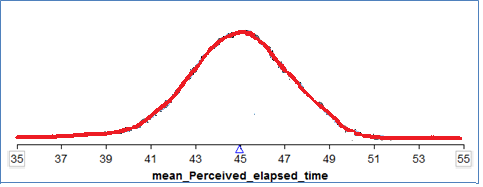
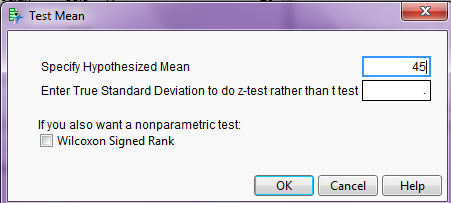
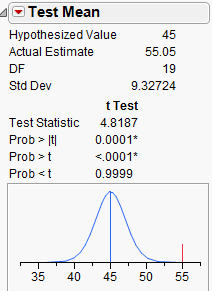
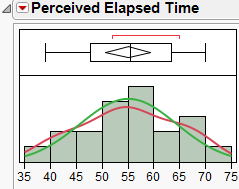
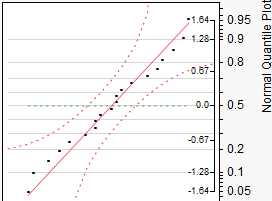
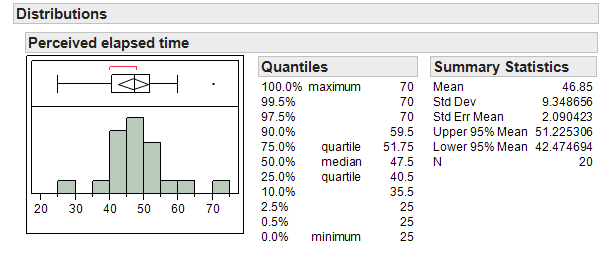
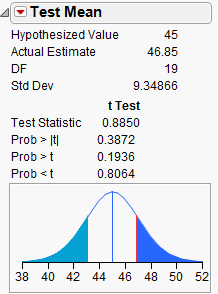
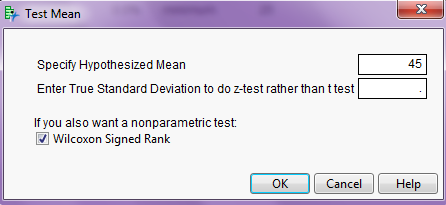
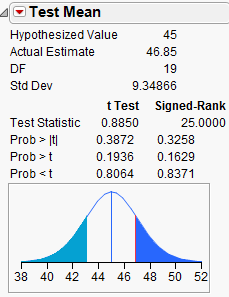
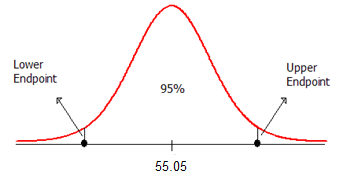


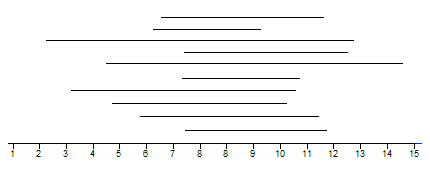
Comments
of interest (recall that the hypothesis test does NOT allow us to do this). Therefore, when available, a confidence interval should always accompany the hypothesis test.
the population parameter. Instead, we center the confidence interval on the sample mean. Consider the following example.